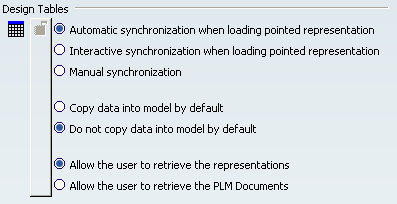Knowledge | ||
| ||
This page deals with the following categories of options in the General > Parameters and measure > Knowledge tab:
Parameter Tree View
 |
- With value
-
Displays the parameter values in the specification tree.
 By default, this option is unchecked.
By default, this option is unchecked. - With formula
-
Displays the formulas constraining the parameter in the specification tree.
 By default, this option is unchecked.
By default, this option is unchecked.
![]()
Relations Update in 3D Shape Context
 |
- Creation of synchronous relations
-
Enables you to create synchronous relations, that is to say relations that will be immediately updated if one of their parameters/inputs is modified. Relations based on parameters are the only one that can be synchronous.
 By default, this option is unchecked
By default, this option is unchecked - Creation of relations evaluated during the global update
-
Enables you to associate the evaluation of asynchronous relations with the global update. The relations can be asynchronous for 2 reasons:
- You want the relations to be asynchronous
- The relation contains measures.
- Relations based on parameters: These relations can be synchronous or asynchronous.
- Relations based on geometry: These relations can only be asynchronous.
- Relations based on parameters and on geometry: For the part
of the relations containing parameters, you decide if you want the
update to be synchronous or not. For the other part of the relations,
the update occurs when the global update is launched.
 By default, this option is checked.
By default, this option is checked.
Important: Note that you can also decide if already existing relations are synchronous or asynchronous. To know more, see Controlling Relations Update in the Infrastructure User's Guide.
![]()
Design Tables
 |
- Automatic Synchronization at Load
-
When loading a model containing user design tables, if the design table files have been modified and the external file data is contained in the model, the design table will be synchronized automatically if this option is selected.
 By default, this option is checked.
By default, this option is checked. - Interactive Synchronization at Load
-
When loading a model containing user design tables whose external source file was deleted, this option enables you to select a new source file or to save the data contained in the design tables in a new file.
 By default, this option is unchecked.
By default, this option is unchecked. - Manual Synchronization
-
When loading a model containing user design tables, if the design table files have been modified and the external file data is contained in the model, the design table will be synchronized if this option is selected. To synchronize both files, right-click the design table in the specification tree and select DesignTable object>Synchronize or Edit>Links.
 By default, this option is unchecked.
By default, this option is unchecked. - Default Mode: Copy Data Into Model
-
If checked, the data contained in the external source file will be copied into the model.
 By default, this option is unchecked.
By default, this option is unchecked. - Default Mode: Do Not Copy Data Into Model
-
If checked, the data contained in the external source file will not be copied into the model.
 By default, this option is checked.
By default, this option is checked. - Allow the user to retrieve the representations
- If checked, enables the user to work with files created before V6R2011.
- Allow the user to retrieve the PLM documents
- If checked, enables the user to work with PLM documents only.
![]() By default, this option is checked.
By default, this option is checked.